| |
Article about building Marshall 200W Leach Amplifier. For many years I looked for construction of HiFi amplifier wit a good parameters, enough power reserve and simple construction. I built a couple of amplifiers with integrated circuits MBA810, TDA2005, LM3886, but I was disappointed by their output quality and noise. I decide to built a classic construction with discrete components and bipolar transistors. Construction from Mr. Dudek was interesting, but I didn't like used components and complexity. All of my requirements satisfied construction of the Leach Amp. Circuit author publicates in a February 1976 in american journal. From these days circuit was not practically changed. Little changes are descripted on authors page.
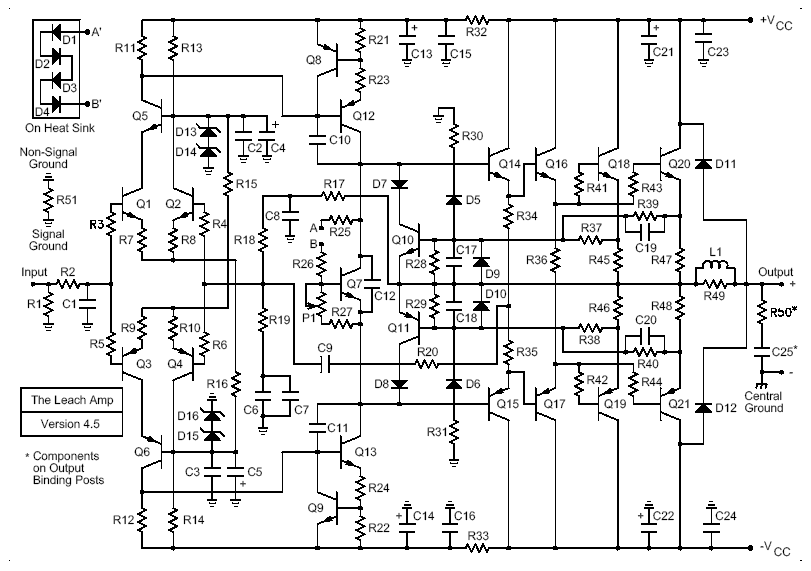
Components
I succeeded to find almost all original components on our local market, which was a miracle. Only a bigger problem was a power transformer and filter capacitors. Recommended toroid transformer for power 200W to 4 ohms is 230V/2x 42V. I succeeded to find in a GM Electronic a toroid transformer 2x36V, 300W. Output power will be a little lower, but for home use it will be more than enough. Voltage after rectification and filtering without load will be about +51V and -51V. I couldn't find capacitors with a 10000uF or 20000uF for 75V. I decided to buy electrolytic capacitors 4700uF/63V and place four pieces parallely on positive voltage and 4 on negative voltage. I was thinking about other option to place 3 pieces of 6800uF/63V on power lines. Mica capacitors are not available at all. I used ceramic instead. Someone said, that ceramic capacitors can "play", but I didn't found any problems. Carbon resistors are allegedly better for Hifi because lower noise, but I hear it after I buyed metalised resistors. I used normal electrolytic capacitors, but probably LowESR types will be better. Power transistors are not original Motorola, or today ON semiconductor, but I didn't found any problem.
Part list for two channels
Transistors
12x Q1, Q2, Q5, Q7, Q9, Q10 MPSA 06
10x Q3, Q4, Q6, Q8, Q11 MPSA 56
4x Q13, Q14 2N 3439
4x Q12, Q15 2N 5416
2x Q16 MJE 15030
2x Q17 MJE 15031
4x Q18, Q20 MJ 15003 (NJL3281D)
4x Q19, Q21 MJ 15004 (NJL1302D)
Diodes
12x D1, D2, D3, D4, D11, D12 1N4007
12x D5, D6, D7, D8, D9, D10 1N4148
8x (15x) D13, D14, D15, D16 20 V Zener +5% tolerance, 0.5W
Capacitors
2x C1 390 pF mica
14x C2, C3, C15, C16, C23, C24, C25 100nF/100V film
8x C7, C12, C17, C18 100nF/50V film
12x C4, C5, C13, C14, C21, C22 100uF/63V radial electrolytic
2x (4x) C6a, C6b 220uF/16V bi-polar electrolytic (4x 330uF/16V)
2x C8 180pF mica
2x C9 47pF mica
4x C10, C11 10pF mica
4x C19, C20 10nF/50V film
Rezistors
All resistors are 1% carbonic or metalised 0,5W if not noted otherwise
2x R1 20 kohm
2x R2 2 kohm
16x R3, R4, R5, R6, R7, R8, R9, R10 300 ohm
6x R11, R12, R27 1.2 kohm
4x R13, R14 2.2 kohm
4x R15, R16 12 kohm
4x R17, R18 11 kohm
2x R19 1.1 kohm
2x R20 22 kohm
4x R21, R22 30 ohm
4x R23, R24 360 ohm
4x R25, R26 1 kohm
4x R28, R29 270 ohm
4x R30, R31 3.9 kohm 1/2 W
6x R32, R33, R51 82 ohm
4x R34, R35 330 ohm
2x R36 220 ohm
8x R37, R38, R39, R40 680 ohm
8x R41, R42, R43, R44 10 ohm 1/2 W
8x R45, R46, R47, R48 0.33 ohm 5 W wire-wound
4x R49, R50 10 ohm, 2 W
Other
2x P1 2 kohm more turn cermet trimmer
1x T1 Toroid power transformer SEC 2x40V AC 300W
8x C1P, C2P 4700uF/63V (6x 6800uF/63V 4x 10000uF/63V)
8x C3P 100nF/200V
1x D1P Bridge rectifier 35A/200V
5x Fuse casing
1x F1 Fuse 3.15A T
4x F2, F3, F4, F5 Fuse 5A F
8x Insulative bed under transistors + screw insulatives 16x
20x Solder eye M4
2m Shrinking spaghetti 4mm
Component prepairing
To prevent DC offset problems is needed to match transistors Q1-Q4 and zener diodes. In original article is a deep description how to do it. With transistors I had not any problems at all. Probably today is their producing more precise, when they are from identical series. With zener diodes it is worse. We connect 20V zener diode in a series with a resistor on the voltage power supply that to set diode current to a 3.3mA. I discovered, that zener voltage changing according to temperature and term of connection to voltage. During measuring I tried to keep identical conditions for all diodes and I waits for steady of value after about 1 minute. I buyed more zener diodes and every piece I measured three times and write down their values. After measuring I collected diode pairs for match voltages on each board.
Next was needed to wind L1 around R49. First I doesn't know which select wire and how their best wind on the resistor. I used lacquered wire from output inductor from an old PC power supply with diameter about 1mm. I wounded 11 turns on a screwdriver with a similar diameter like a R49. Finished inductor I placed on R49, turn their ends and solder them on the resistor terminals. Resistor with an inductor is normally soldered to board.
Circuit board
I used original circuit board layout version 4.5 which looks perfectly suitable. Circuit board is one sided, nice symmetrically designed and all components fits to them perfectly. Only one little problem was small solder spots. It's not possible to drill a little bigger holes. First piece of circuit board I redrawed to an Eagle and consequently plot it on cuprextit and etch it. Next I leave them to make at Mr. Kohout which makes simple circuit boards by photo path. I only tell him page, where was circuit board published in Aradio magazine. Concretly "Praktická elektronika A Radio - 11/2002 page 13". Because he already had film negative, that curcuit board was cheaper. Circuit board was varnished to prevent oxidation and better soldering. Before assembling is suitable to check, that all holes are sufficient for components and wires. When I increased hole on an assembled board, I little damaged a case of one electrolytic capacitor.
Original printed circuit board with heatsink drilling: http://users.ece.gatech.edu/~mleach/lowtim/graphics/layouts.pdf
Rearranged PCB for direct assembling NJL transistors. I had to make smaller PCB than original thanks to limited Light version of Eagle, but I hope that it is OK.
Printed circuit board in Eagle5 format: leachamp4_5.brd
Printed circuit board in PDF: leachamp4_5brd.pdf
Printed circuit board in Postscript: leachamp4_5.brd.ps
Assembling
It's good to begin assembling of circuit board from the smallest components to largest. First I soldered short-circuit jumper. Next I assembled all small resistors and after them diodes. I checked resistor values and diode polarity with a multimeter before assembling. Next I assembled small capacitors and smallest, middle and largest transistors. Specially I doublechecked their position. There remaining only big resistors and electrolytic capacitors, where I specially check polarity. It's needed to right turn pins on Q16 and Q17 in line with hole position and thickness of small heat sink.
Heat sink
I couldn't find suitable heat sink for a long time. I found perfect profile at small vendor, but it was much shorter than I needed it. Finally I obtained contact on a company ALUPA, which has in their list aluminium profile which fits exactly for our amplifier. Profile has marking ZH-2476. Unfortunately I doesn't know exactly required size, that I had to cut them with a circular saw, which going very badly, because aluminium "flows". Finally I cut heat sink to lenght 15cm and drilled to them holes according to original PDF document by 4mm drill except diodes. Holes for diodes I drilled to their tight contact with heat sink. Collector of power transistors I connected from upper side with help of solder eye and thick wire. I drilled holes for wires between transistors, but it was not a good idea, because I had to a little nibble mica beds. Better will be to make holes on the side of transistors.
Transistors are attached this way: First I spread his inner side with a thin layer of silicon vaseline. Next I attached on them mica bed. Next I soldered two thicker wires long 10cm, attached a piece of shrinkage spaghetti and shrink with lighter. Wires to collectors must be longer for about 5cm. Next I spreaded mica bed from the other side too. Layer must be very thin, because vaseline tried to push out. Finally I gave transistor on his place on the heat sink, in to the holes I placed screw isolant, under one I gave solder eye with soldered thicker wire and I screw up M3 15mm screws. In to the heat sink I placed and solder up 4 diodes according to original document and I drop them with glue. I drilled a small holes in a corners of the heat sink and I made worm with a M3 screw-cutter. I placed 5mm M3 spacer leg. For better heat removal is good to place blacked heat sink vertically, but I was limited by space and technological possibilities. However I didn't see any problems with overheating.
Mechanical construction
In construction I comes again from original organization. I had available old casing from some device with height 12cm, width 48cm and depth 25cm. On the front panel is placed only power switch and four diodes. Two for positive and negative supply and two for clipping indicator of the left and right channel. Front panel from aluminium I polished, that now it looks almost like a mirror. On them is placed logo made from cuprextit and glued with both sides sealing tape. But it doesn't look much good.
Toroid transformer is placed in a center close to front panel far from electronics due to interference reason. He is attached with a bigger screw to base of the chassis. Nearby is central isolated ground point and bridge rectifier. Protective ground wire is connected from the power plug to the metal chassis. Ground from plug is not connected with a central amplifier ground for preventing ground loops and interference problems.
On the left and right side from the transformer are located filter capacitors placed vertically. Between them is longer screw with a female screw and plastic hose for preventing of wearing through capacitor insulation. On the top of the screw is placed bigger rubber pad with a female screw. Capacitors are binded together. Strong power wires are from one piece of wire and goes from rectifier over all filter capacitors to fuse holders. Maybe is better to connect all capacitors with same long wires to star, but I haven't idea how to do it mechanically. Identically is made second power line and groud line from central ground point.
Circuit boards are placed in a case vertically about 3cm from back side components backward. Originally i want to place boards with components to front, but it is much difficult to solder wires to boards. Circuit boards and transistors on heat sinks are placed mirrored that input of the amplifier has very short connection wires. Boards are placed on the longer distance legs. I hadn't them, that I used longer screws with female screws. Under two female screws I had to place insulation pads, because one of wires was too close screw. All ground wires are leaded independently to central ground point.
Back panel has on one side power plug connector and fuse holder. I made mistake here, because socket is in line with speaker connector, that can conflicts with speaker wires. Beside is speaker terminal and next heat sink of the right channel screwed with four screws on the distance legs. In the middle are two gilded input cinch connectors. They must be isolated from case! Next is heat sink of the left channel and again speaker connector. R50 and C25 are soldered directly on the speaker terminals. I founded only nickeled terminals not gilded, but they are enough massive for big power. TO3 bases or insulation covers are not available on our market.
Chassis wiring
On the circuit we can see connecting of individual components in a chassis. After power socket is connected EMI filter, which reduce interference between amplifier and neighbourhood. It can be seen in compact version in the power socket. In original amplifier I haven't them. In circuit is indicated which wires are thicker. Concrete component placing is seen on photos.
Clipping indicator
It's possible to build a clipping indicator like accesory for amplifier which detects amplifier limitation, when output transistors are fully opened and signal is cutted close to power supply voltage. In this case is acoustic signal distorted in a power amplifier. Circuit as usually is from authors pages. I redraw them in a Eagle and I designed circuit board for two channels. I added place for two LEDs for power supply voltage indicators. This board have small pads, which is not much good. Eagle has these pads too small in default state.
Schematics diagram
Schematics in an Eagle
Circuit board
Circuit board in an Eagle
Circuit board in a PDF
Partlist for clipping indicator
number name value
2x Q1, Q3 BC639
2x Q2, Q4 BC640
6x D1-D6 1N4148
2x LED1, LED2 LED 2mm flat face, red
2x LED3, LED4 LED 2mm flat face, green
2x C1, C2 10uF/100V
4x R1, R2, R8, R9 12k
4x R3, R4, R10, R11 16k
4x R5, R6, R12, R13 1k5 2W
2x R7, R14 220R
2x R15, R16 22k
Testing
First we must to test power supply part. Fuses F2 to F5 we leave out and for sure we check again circuit of rectifier and capacitor polarity. a zkontrolujeme pro jistotu zapojení usměrňovače a polaritu kondenzátorů. Possible error can be fatal. If is all OK, that on capacitors will be voltage about 51V. Exact voltage depends on used transformer and power line voltage. After disconnecting will be voltage on capacitor for a long time. We can discharge them with a resistor 100R 2W. It's possible, that with power-on blows fuse F1 even all is OK. In my situation is charging current too big, that I had place NTC thermistor in a series with primary transformer side. I get them from old PC power supply, where it has identical function. Better idea is to use "soft start" circuit, which is made from big resistor on primary side of transformer and relay, which short-circuit resistor after few seconds. I didn't found any circuit which I liked it.
When the power supply works correctly, we can go to test amplifier. First we set trmmer P1 to one end position with maximum resistance. In to the fuse holders for one channel we place resistors 100R 1/4W. With disconnected output and input we can power-on amplifier. On the resistor we would measure maximally 2.5V, which matches current 25mA. If is everything allright, we wait for discharging after power-off and replace resistor with fuses. Initially for testing we can use smaller values. I had switched two wires from power transistors on one channel and resistors smokes and smells. Really is better to everything double check.
Now we must set the bias current. Use amperemeter in place of F2. Turn the trimmer P1, until is current 100mA. How amplifier warming-up current is changing. Regulate current value when it is stabilized, which can be after 15 minutes. Identical procedure repeat for second channel.
With disconnected input we can measure DC offset on the output. In my example I measured 19mV on left channel and 22mV on right channel.
Now we can made regular tests and connects speakers and signal source. I tested with connecting of the amplifier input directly on the output of soundcard. You must carefully increase volume, because amplifier has enough power to destroy small speakers.
End
My goal was to build perfect power amplifier, which I succeeded. It has enough power reserve for dynamic in a recordings and unhearable interference or noise. Now I must resolve quality signal source, because output from soundcard Sounblaster Live! contains a many computer interference. Probably I built quality DAC from USB or SPDIF. Maybe like a piece of preamplifier which will have switch for more inputs and volume control.
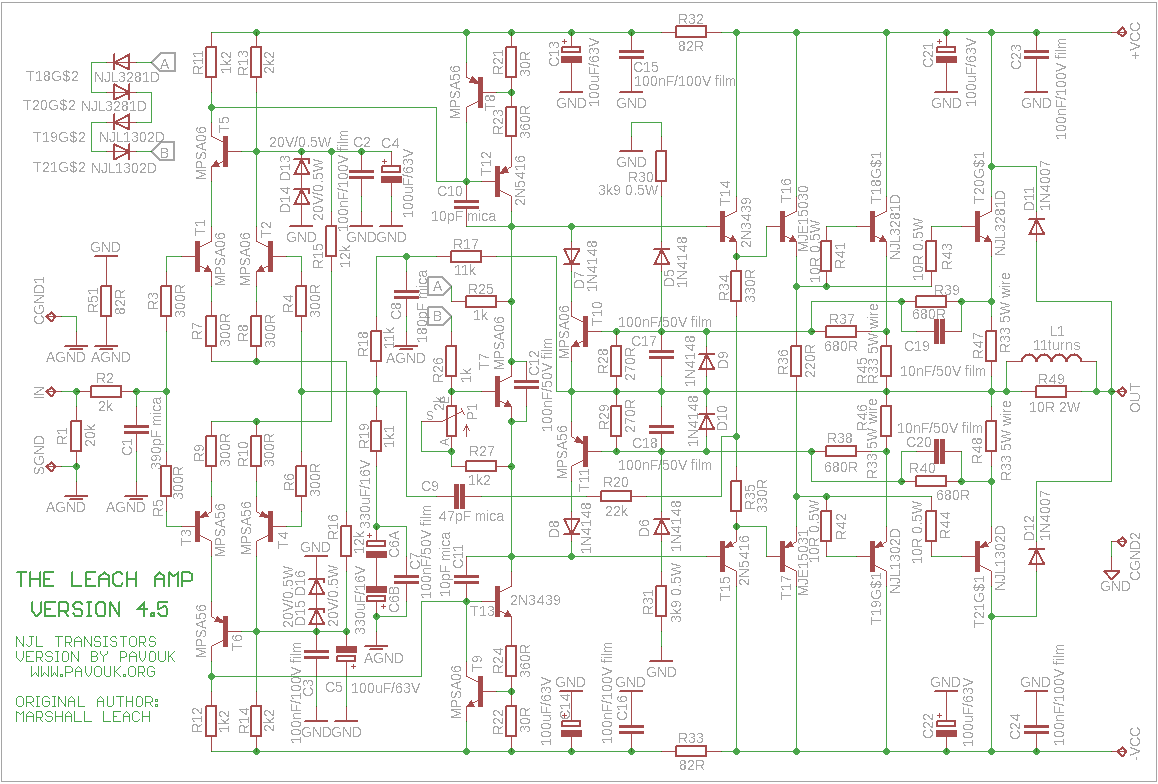
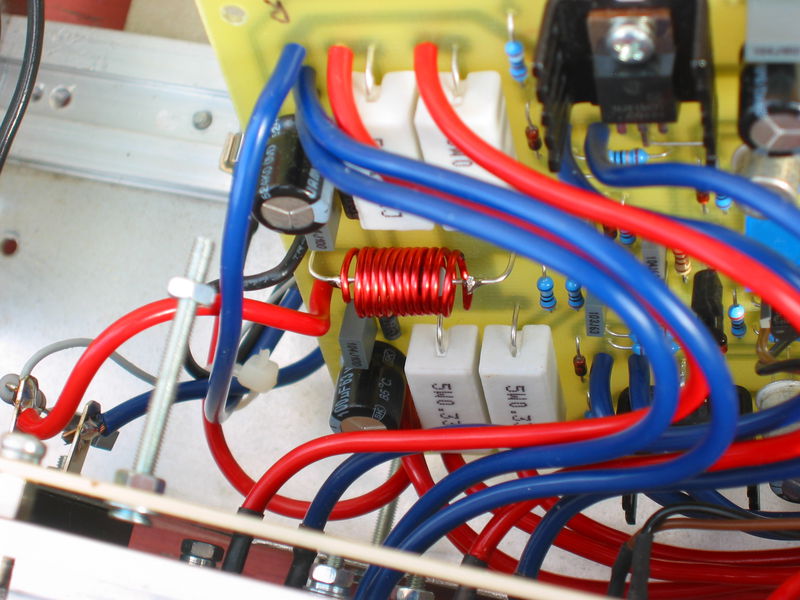
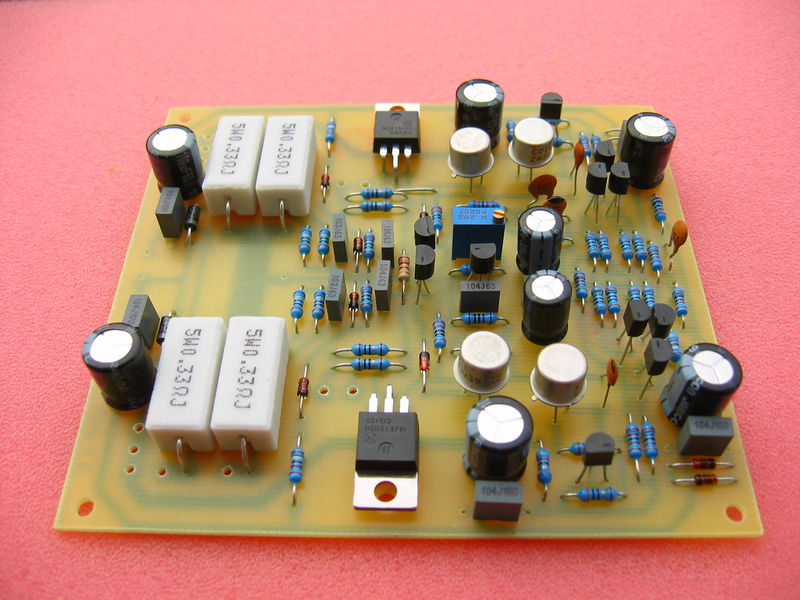
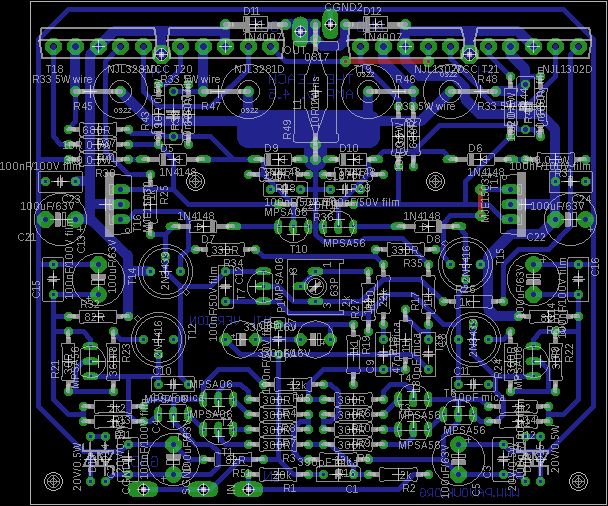
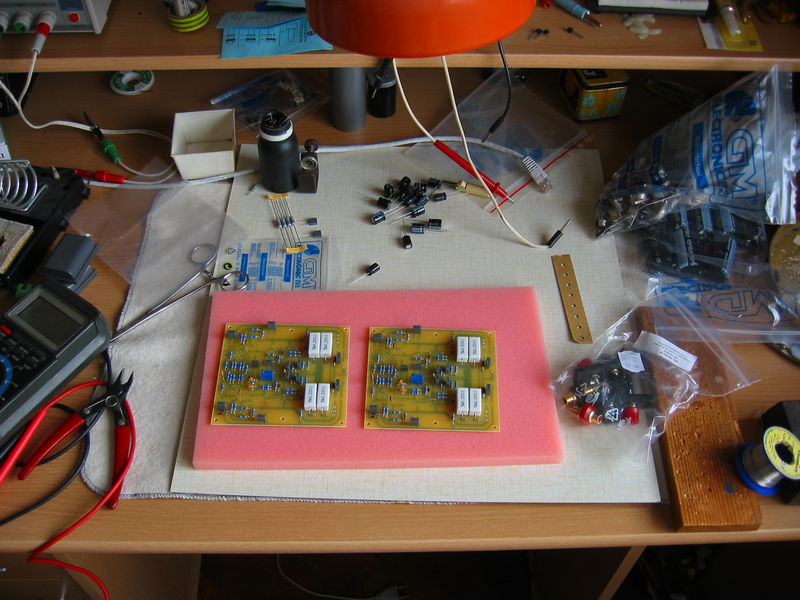
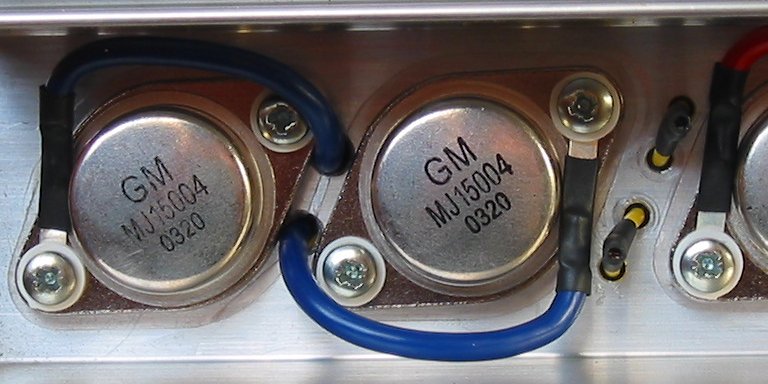
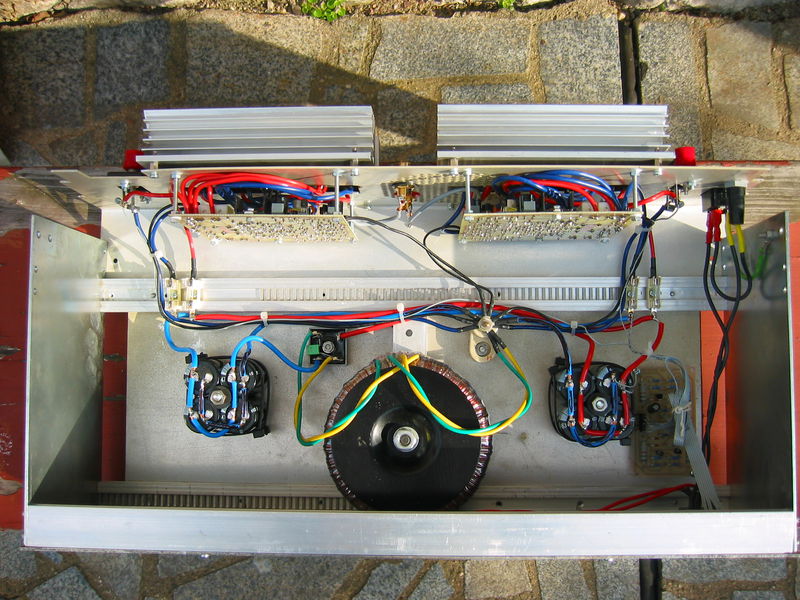
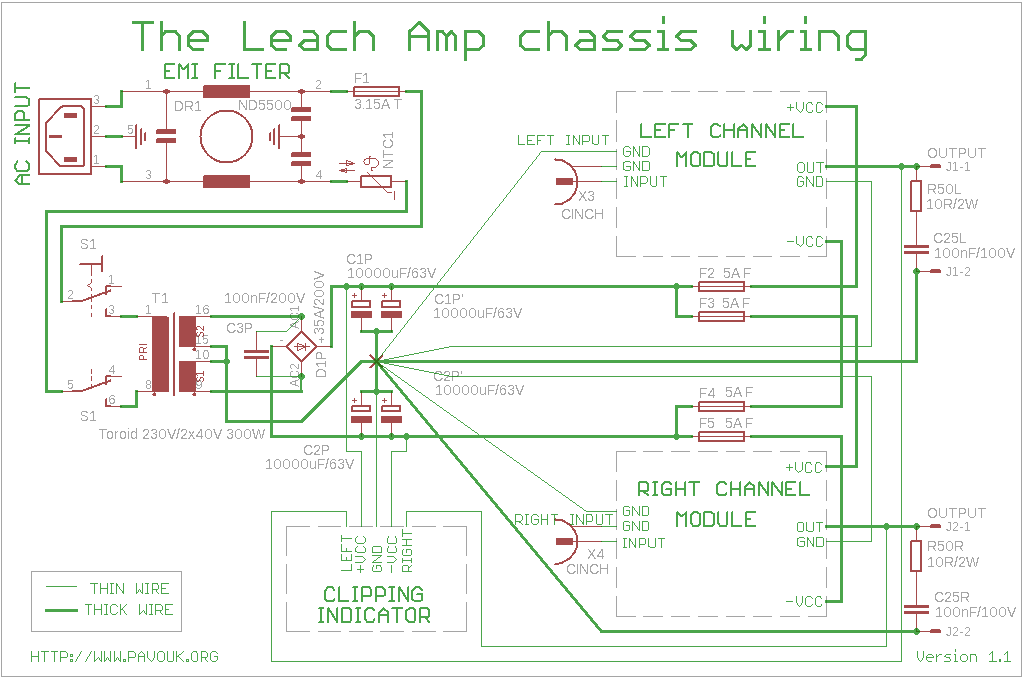
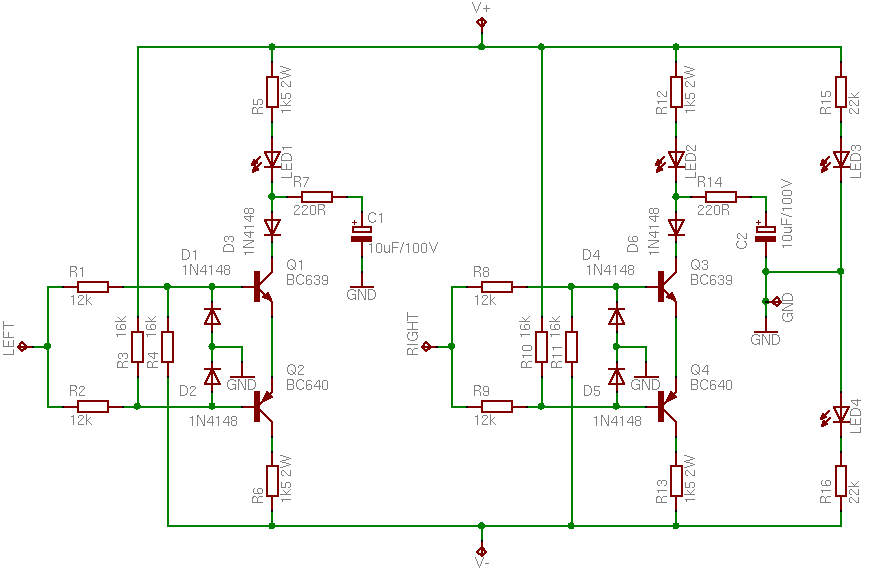
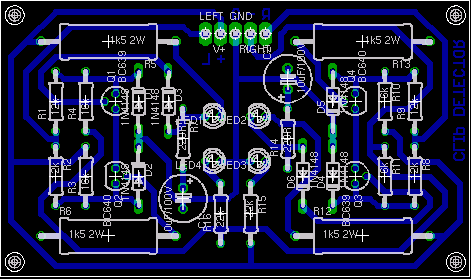
|
|
|
| |
Accurate LC Meter
Build your own Accurate LC Meter (Capacitance Inductance Meter) and start making your own coils and inductors. This LC Meter allows to measure incredibly small inductances making it perfect tool for making all types of RF coils and inductors. LC Meter can measure inductances starting from 10nH - 1000nH, 1uH - 1000uH, 1mH - 100mH and capacitances from 0.1pF up to 900nF. The circuit includes an auto ranging as well as reset switch and produces very accurate and stable readings. |
|
PIC Volt Ampere Meter
Volt Ampere Meter measures voltage of 0-70V or 0-500V with 100mV resolution and current consumption 0-10A or more with 10mA resolution. The meter is a perfect addition to any power supply, battery chargers and other electronic projects where voltage and current must be monitored. The meter uses PIC16F876A microcontroller with 16x2 backlighted LCD. |
|
|
|
60MHz Frequency Meter / Counter
Frequency Meter / Counter measures frequency from 10Hz to 60MHz with 10Hz resolution. It is a very useful bench test equipment for testing and finding out the frequency of various devices with unknown frequency such as oscillators, radio receivers, transmitters, function generators, crystals, etc. |
|
1Hz - 2MHz XR2206 Function Generator
1Hz - 2MHz XR2206 Function Generator produces high quality sine, square and triangle waveforms of high-stability and accuracy. The output waveforms can be both amplitude and frequency modulated. Output of 1Hz - 2MHz XR2206 Function Generator can be connected directly to 60MHz Counter for setting precise frequency output. |
|
|
|
BA1404 HI-FI Stereo FM Transmitter
Be "On Air" with your own radio station! BA1404 HI-FI Stereo FM Transmitter broadcasts high quality stereo signal in 88MHz - 108MHz FM band. It can be connected to any type of stereo audio source such as iPod, Computer, Laptop, CD Player, Walkman, Television, Satellite Receiver, Tape Deck or other stereo system to transmit stereo sound with excellent clarity throughout your home, office, yard or camp ground. |
|
USB IO Board
USB IO Board is a tiny spectacular little development board / parallel port replacement featuring PIC18F2455/PIC18F2550 microcontroller. USB IO Board is compatible with Windows / Mac OSX / Linux computers. When attached to Windows IO board will show up as RS232 COM port. You can control 16 individual microcontroller I/O pins by sending simple serial commands. USB IO Board is self-powered by USB port and can provide up to 500mA for electronic projects. USB IO Board is breadboard compatible. |
|
|
|
|
ESR Meter / Capacitance / Inductance / Transistor Tester Kit
ESR Meter kit is an amazing multimeter that measures ESR values, capacitance (100pF - 20,000uF), inductance, resistance (0.1 Ohm - 20 MOhm), tests many different types of transistors such as NPN, PNP, FETs, MOSFETs, Thyristors, SCRs, Triacs and many types of diodes. It also analyzes transistor's characteristics such as voltage and gain. It is an irreplaceable tool for troubleshooting and repairing electronic equipment by determining performance and health of electrolytic capacitors. Unlike other ESR Meters that only measure ESR value this one measures capacitor's ESR value as well as its capacitance all at the same time. |
|
Audiophile Headphone Amplifier Kit
Audiophile headphone amplifier kit includes high quality audio grade components such as Burr Brown OPA2134 opamp, ALPS volume control potentiometer, Ti TLE2426 rail splitter, Ultra-Low ESR 220uF/25V Panasonic FM filtering capacitors, High quality WIMA input and decoupling capacitors and Vishay Dale resistors. 8-DIP machined IC socket allows to swap OPA2134 with many other dual opamp chips such as OPA2132, OPA2227, OPA2228, dual OPA132, OPA627, etc. Headphone amplifier is small enough to fit in Altoids tin box, and thanks to low power consumption may be supplied from a single 9V battery. |
|
|
|
|
|
Arduino Prototype Kit
Arduino Prototype is a spectacular development board fully compatible with Arduino Pro. It's breadboard compatible so it can be plugged into a breadboard for quick prototyping, and it has VCC & GND power pins available on both sides of PCB. It's small, power efficient, yet customizable through onboard 2 x 7 perfboard that can be used for connecting various sensors and connectors. Arduino Prototype uses all standard through-hole components for easy construction, two of which are hidden underneath IC socket. Board features 28-PIN DIP IC socket, user replaceable ATmega328 microcontroller flashed with Arduino bootloader, 16MHz crystal resonator and a reset switch. It has 14 digital input/output pins (0-13) of which 6 can be used as PWM outputs and 6 analog inputs (A0-A5). Arduino sketches are uploaded through any USB-Serial adapter connected to 6-PIN ICSP female header. Board is supplied by 2-5V voltage and may be powered by a battery such as Lithium Ion cell, two AA cells, external power supply or USB power adapter. |
|
200m 4-Channel 433MHz Wireless RF Remote Control
Having the ability to control various appliances inside or outside of your house wirelessly is a huge convenience, and can make your life much easier and fun. RF remote control provides long range of up to 200m / 650ft and can find many uses for controlling different devices, and it works even through the walls. You can control lights, fans, AC system, computer, printer, amplifier, robots, garage door, security systems, motor-driven curtains, motorized window blinds, door locks, sprinklers, motorized projection screens and anything else you can think of. |
|
|
|